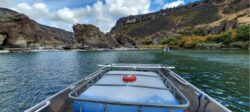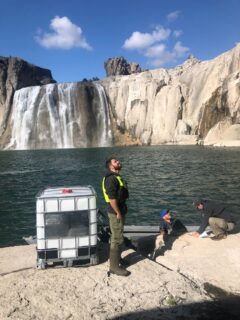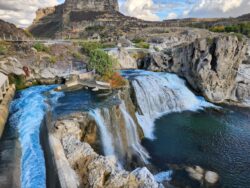by Terry McNabb, Aquatic biologist/Lake manager, Aquatechnex
Zebra and quagga mussels are a major threat to the waters of the Pacific Northwest. These invasive species were first discovered in the Great Lakes in the 1980’s and are assumed to have been introduced from Europe via ballast water carried by ocean-going cargo ships. These species reproduce rapidly; one mussel can generate up to 14,000 larva or veligers per year.
Upon introduction to the Great Lakes, they rapidly affected the environment and public works in the region. As filter feeders, they reduced the levels of algae in these systems. Scientists calculated they were filtering the entire volume of Lake Erie every four days, crushing the fishery present at that time. They also clogged water intakes for potable supply, industry, and most alarmingly, nuclear power plants on the lakes.
The Great Lakes are connected to the Mississippi Drainage in Chicago, Illinois. Chicago became a town and then a city primarily because it was a very short portage from the Great Lakes to the Fox and Illinois Rivers and on to the Mississippi. As Chicago grew, the municipal waste being discharged into Lake Michigan began to affect the city’s drinking water supply. Their solution was to dig a connection to the Illinois River and “flush” that waste downstream into the Mississippi drainage. With the connection in place, mussel larva easily flowed to this watershed. They were then (unintentionally) barged up and down the river system and into the Missouri and Ohio Rivers.
The Rocky Mountains were generally thought to be a barrier to movement into the extensive Columbia River Basin and the important resources therein. States like Idaho took on the role of stopping the spread of quaggas into this area.
The Idaho Department of Agriculture (ISDA) has had an extensive prevention and detection program for over a decade. This includes check stations at border crossings where trained biologists inspect all watercraft that pass through. It has also included a large sampling program of all significant waterbodies in the state using DNA analysis.
In mid-September of this year, one of the DNA samples collected from the Snake River around Twin Falls showed a positive hit for quagga mussel DNA. This mobilized an extensive effort by ISDA to determine whether there was in fact an introduction in this area; this sampling found that the worst fears were realized. Larva (also called veligers) were found, and one live quagga mussel was discovered by ISDA divers in the canyons around Twin Falls.
The ISDA had a rapid response program ready to go for just this emergency and they implemented it at once. This area of the Snake River had deep canyons and waterfalls and access was a challenge. The state mobilized the National Guard to isolate the waters and use helicopters to move treatment vessels and equipment into place.
There is a US EPA-registered mussel larvicide available and the ISDA used it to treat the Snake River at this location. Natrix is a chelated copper product that impacts both adult mussels and veligers. The river was treated by ISDA and contractors, and biologists set up injection systems to maintain a lethal concentration for 96 hours twice with a short interval in between.
Several test organisms were placed in the treatment area to gauge impact and targeting them was successfully. It is hoped that this treatment was performed early enough to prevent significant downstream damage.
The Snake River is an important tributary of the Columbia River, where the mussels would have a devastating impact on commerce, hydroelectric production, agriculture, and endangered salmon species. Veligers can easily move with the flow of the water downstream and establish. Hopefully this was caught in time and the treatments were effective.
While ISDA has probably won the first volley in the war against a quagga infestation, all of us in the Columbian Basin need to sharpen our awareness of the threat posed by this invasive species, strengthen reconnaissance and boat check stations, and have rapid response plans in place to target them if found.
For additional information, please visit: Snake River Quagga Mussel – Idaho State Department of Agriculture













